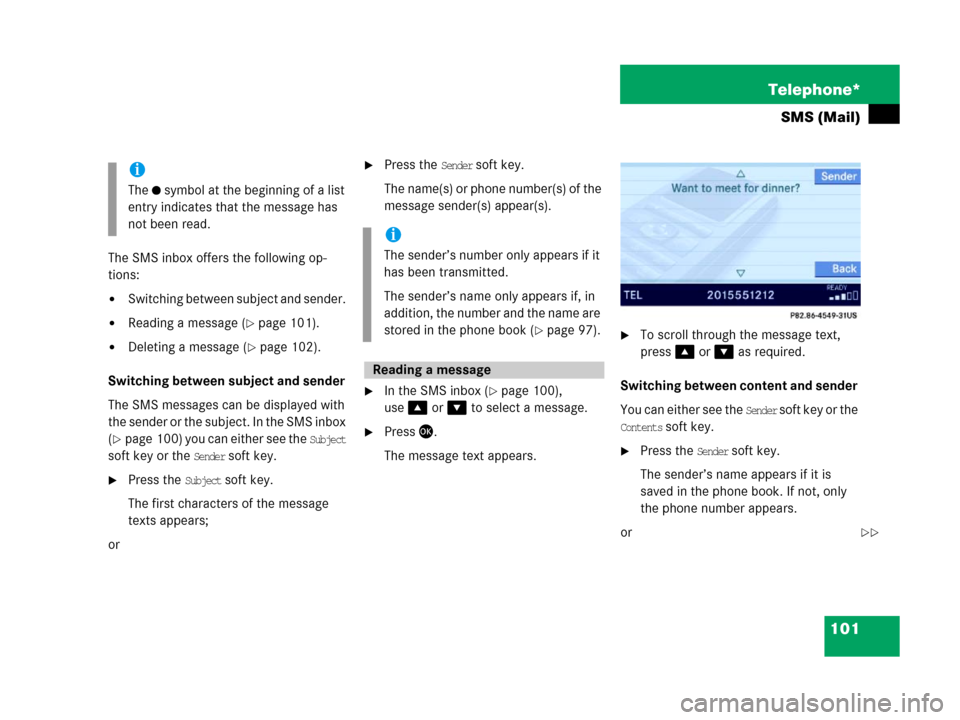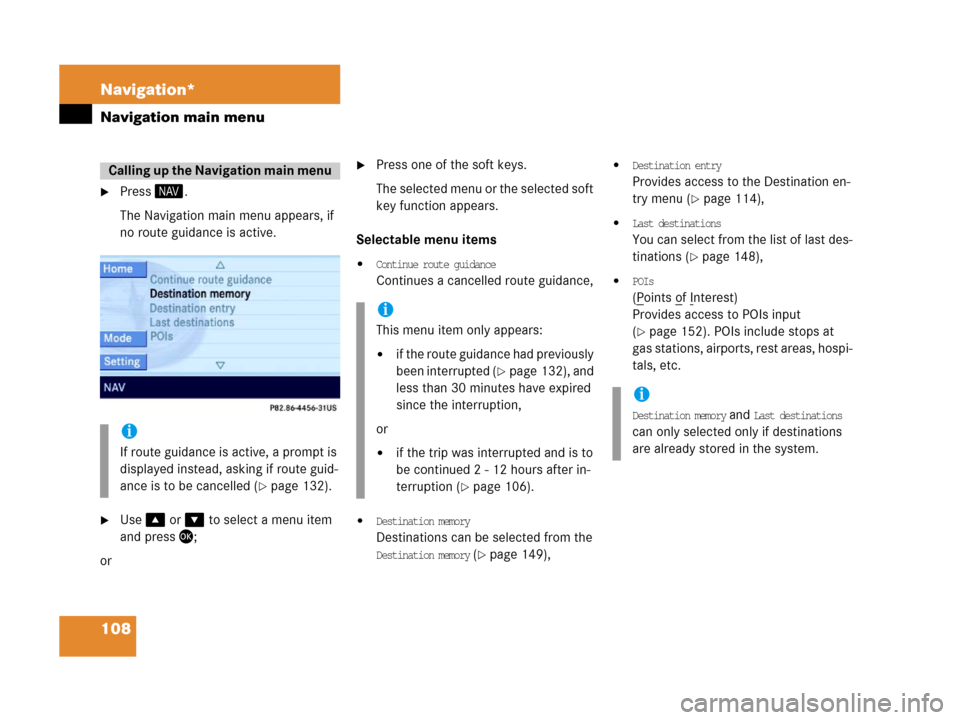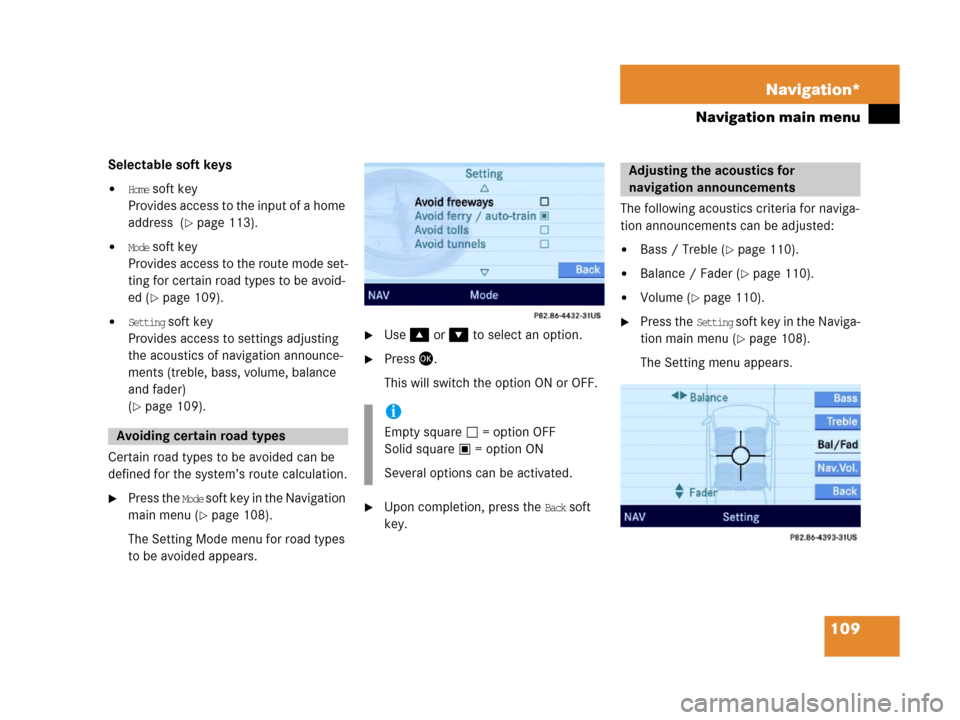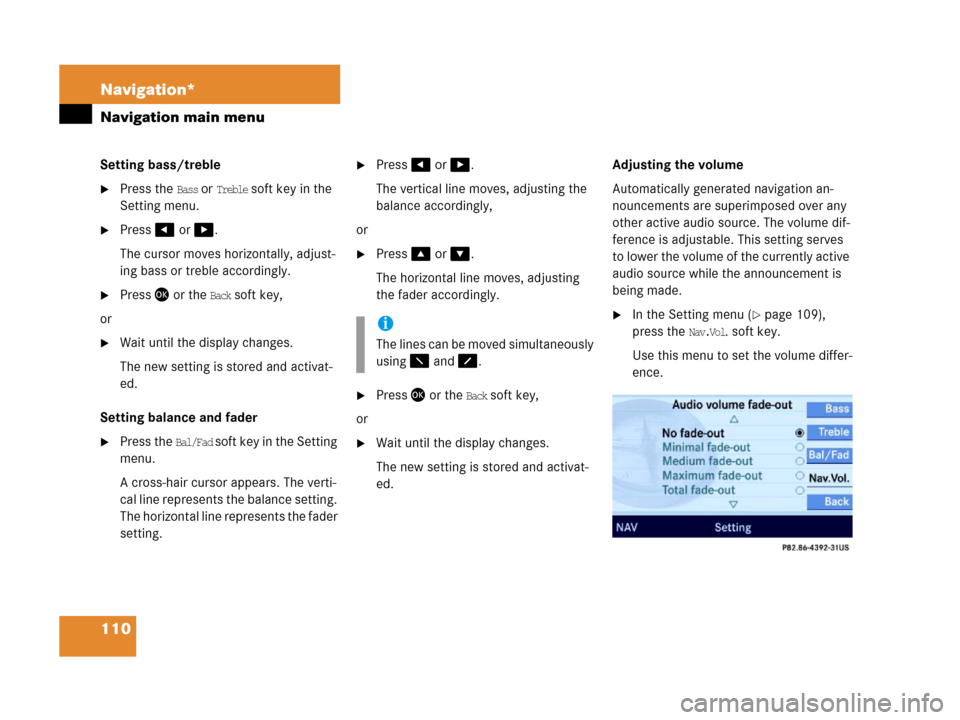Page 100 of 187
99 Telephone*
Phone book
�Presss .
The telephone initiates the connection
with the selected number.
If your vehicle is equipped with voice con-
trol system* you can add up to 20 spoken
names to each phone book entry.
Via the voice control system* you can dial
a number by speaking the name.
(
�Voice control system* Operator's man-
ual).
�Select a phone book entry (�page 98).
�Press the New soft key.
The voice control system* prompts you
to speak a name.
�Speak the name.
The voice control system* prompts you
to speak the name again.
�Repeat the name.
The name is stored.
�Select the phone book entry to be de-
leted from COMAND (
�page 98).
�Press the Delete soft key.
The delete prompt is displayed.
�Use# to select the menu item Yes.
�Press'.
The entry is deleted.
Adding spoken names to a phone
book entry
Deleting a phone book entry
Page 101 of 187
100 Telephone*
SMS (Mail)
SMS messages can be received if your ve-
hicle is equipped with a telephone and
SMS messaging is available from your car-
rier.
Received messages are saved in the folder
SMS inbox.
�Open the Telephone main menu
(
�page 89).
�Press the SMS soft key.
The folder SMS inbox appears.The SMS inbox shows the list of re-
ceived messages. The list is sorted
chronologically, the last message re-
ceived is displayed at the top of the list.
The corresponding date and time ap-
pears in the status bar when the select-
ed message has been received.
�Use% or & to select another mes-
sage.
i
Incoming new messages are indicated
by the symbol in the status bar.
Symbol appears in the status bar if
the SMS memory is full.
In addition, a corresponding message
is displayed when the folder is opened.
SMS inbox
i
If no SMS messages have been re-
ceived the
SMS soft key is without func-
tion and therefore shaded out.
Page 102 of 187

101 Telephone*
SMS (Mail)
The SMS inbox offers the following op-
tions:
�Switching between subject and sender.
�Reading a message (�page 101).
�Deleting a message (�page 102).
Switching between subject and sender
The SMS messages can be displayed with
the sender or the subject. In the SMS inbox
(
�page 100) you can either see the Subject
soft key or the
Sender soft key.
�Press the Subject soft key.
The first characters of the message
texts appears;
or
�Press the Sender soft key.
The name(s) or phone number(s) of the
message sender(s) appear(s).
�In the SMS inbox (�page 100),
use% or & to select a message.
�Press'.
The message text appears.
�To scroll through the message text,
press% or & as required.
Switching between content and sender
You can either see the
Sender soft key or the
Contents soft key.
�Press the Sender soft key.
The sender’s name appears if it is
saved in the phone book. If not, only
the phone number appears.
or
i
The symbol at the beginning of a list
entry indicates that the message has
not been read.
i
The sender’s number only appears if it
has been transmitted.
The sender’s name only appears if, in
addition, the number and the name are
stored in the phone book (
�page 97).
Reading a message
��
Page 103 of 187
102 Telephone*
SMS (Mail)
�Press the Contents soft key.
The message text appears;
�To return to the SMS inbox press the
Back soft key.
�In the SMS inbox (�page 100),
use% or &0to select the message
to be deleted.
�Press the Delete soft key.
A delete prompt is displayed.
�Use# to select the menu item Yes.
�Press'.
The message is now deleted.
�Press the Back soft key.
This returns you to the Telephone main
menu.
Deleting a message
Exiting from the SMS menu
Page 108 of 187
107 Navigation*
Important notes
�Continuation of the trip more than 12
hours after interruption:
Route guidance must be restarted.
�Select the destination from the Last
destinations
memory (�page 148),
or
�Re-enter the destination
(
�page 114).
Some menus provide lists from which you
can select an item.
Example: Menu to select a streetYou can select a list item using% or &.
If, as shown in the example, you can see
the
Page soft keys, then you can use the
soft keys to scroll up or down the list, page
by page.
As soon as you reach the beginning or end
of a list, the appropriate soft key is deacti-
vated.
Selection lists
Page 109 of 187

108 Navigation*
Navigation main menu
�Press 5.
The Navigation main menu appears, if
no route guidance is active.
�Use% or & to select a menu item
and press';
or
�Press one of the soft keys.
The selected menu or the selected soft
key function appears.
Selectable menu items
�Continue route guidance
Continues a cancelled route guidance,
�Destination memory
Destinations can be selected from the
Destination memory (�page 149),
�Destination entry
Provides access to the Destination en-
try menu (
�page 114),
�Last destinations
You can select from the list of last des-
tinations (
�page 148),
�POIs
(Points of Interest)
Provides access to POIs input
(
�page 152). POIs include stops at
gas stations, airports, rest areas, hospi-
tals, etc.
Calling up the Navigation main menu
i
If route guidance is active, a prompt is
displayed instead, asking if route guid-
ance is to be cancelled (
�page 132).
i
This menu item only appears:
�if the route guidance had previously
been interrupted (
�page 132), and
less than 30 minutes have expired
since the interruption,
or
�if the trip was interrupted and is to
be continued 2 - 12 hours after in-
terruption (
�page 106).
i
Destination memory and Last destinations
can only selected only if destinations
are already stored in the system.
Page 110 of 187

109 Navigation*
Navigation main menu
Selectable soft keys
�Home soft key
Provides access to the input of a home
address (
�page 113).
�Mode soft key
Provides access to the route mode set-
ting for certain road types to be avoid-
ed (
�page 109).
�Setting soft key
Provides access to settings adjusting
the acoustics of navigation announce-
ments (treble, bass, volume, balance
and fader)
(
�page 109).
Certain road types to be avoided can be
defined for the system’s route calculation.
�Press the Mode s o f t k e y i n t h e N a v i g a t i o n
main menu (
�page 108).
The Setting Mode menu for road types
to be avoided appears.
�Use% or & to select an option.
�Press '.
This will switch the option ON or OFF.
�Upon completion, press the Back soft
key.The following acoustics criteria for naviga-
tion announcements can be adjusted:
�Bass / Treble (�page 110).
�Balance / Fader (�page 110).
�Volume (�page 110).
�Press the Setting soft key in the Naviga-
tion main menu (
�page 108).
The Setting menu appears.
Avoiding certain road types
i
Empty square = option OFF
Solid square = option ON
Several options can be activated.
Adjusting the acoustics for
navigation announcements
Page 111 of 187

110 Navigation*
Navigation main menu
Setting bass/treble
�Press the Bass or Treble soft key in the
Setting menu.
�Press# or $.
The cursor moves horizontally, adjust-
ing bass or treble accordingly.
�Press' or the Back soft key,
or
�Wait until the display changes.
The new setting is stored and activat-
ed.
Setting balance and fader
�Press the Bal/Fad soft key in the Setting
menu.
A cross-hair cursor appears. The verti-
cal line represents the balance setting.
The horizontal line represents the fader
setting.
�Press# or $.
The vertical line moves, adjusting the
balance accordingly,
or
�Press% or &.
The horizontal line moves, adjusting
the fader accordingly.
�Press' or the Back soft key,
or
�Wait until the display changes.
The new setting is stored and activat-
ed.Adjusting the volume
Automatically generated navigation an-
nouncements are superimposed over any
other active audio source. The volume dif-
ference is adjustable. This setting serves
to lower the volume of the currently active
audio source while the announcement is
being made.
�In the Setting menu (�page 109),
press the
Nav.Vol. soft key.
Use this menu to set the volume differ-
ence.i
The lines can be moved simultaneously
using 7 and 8.